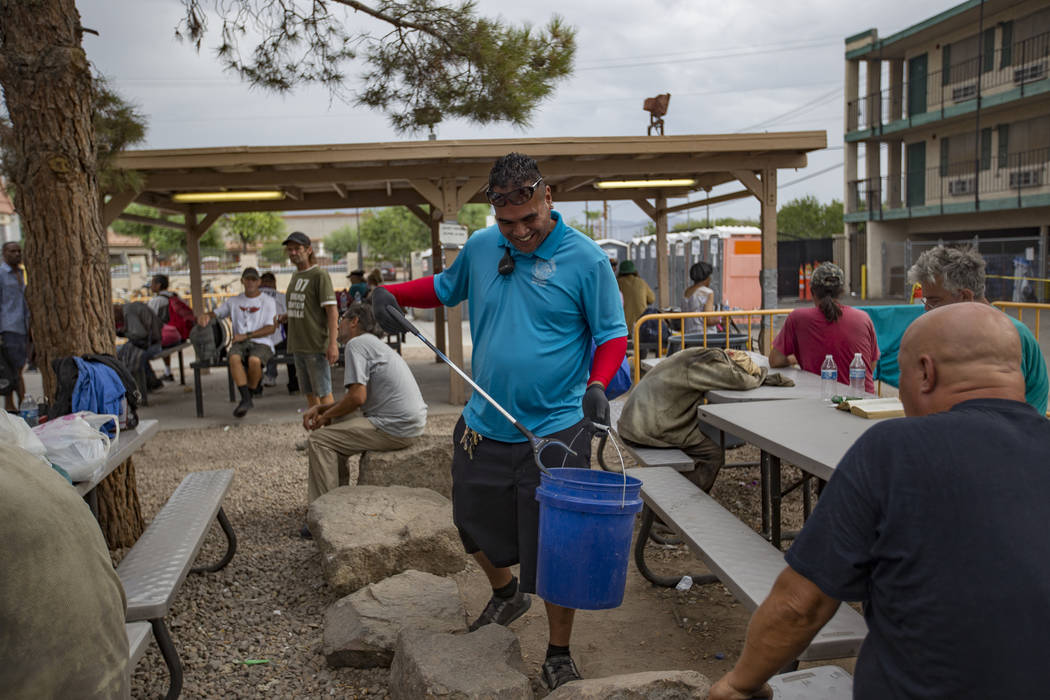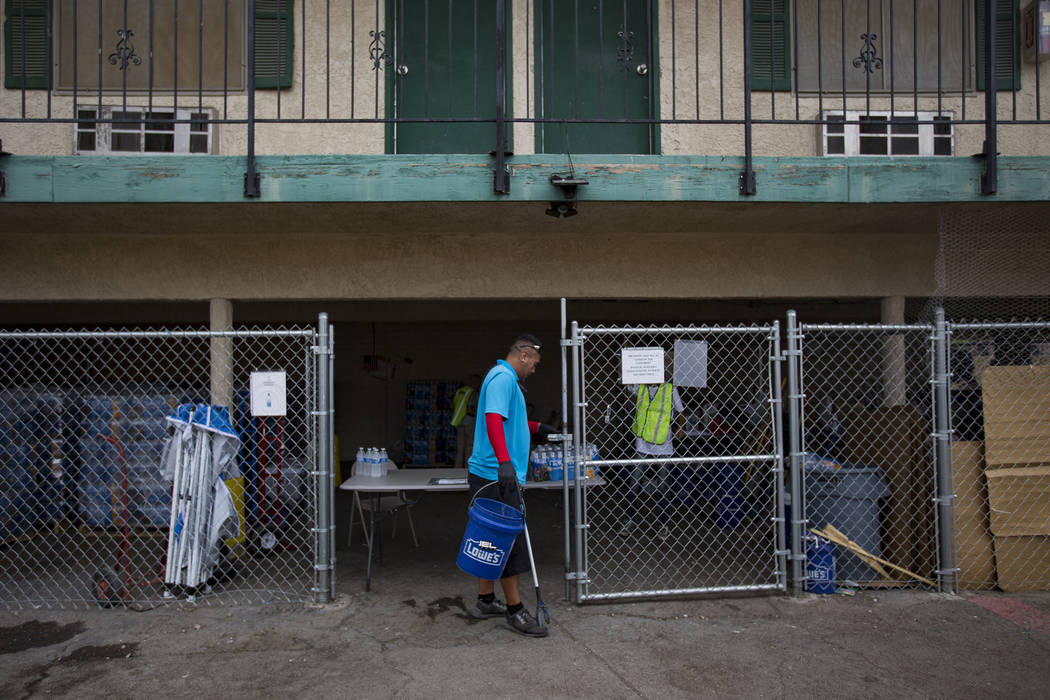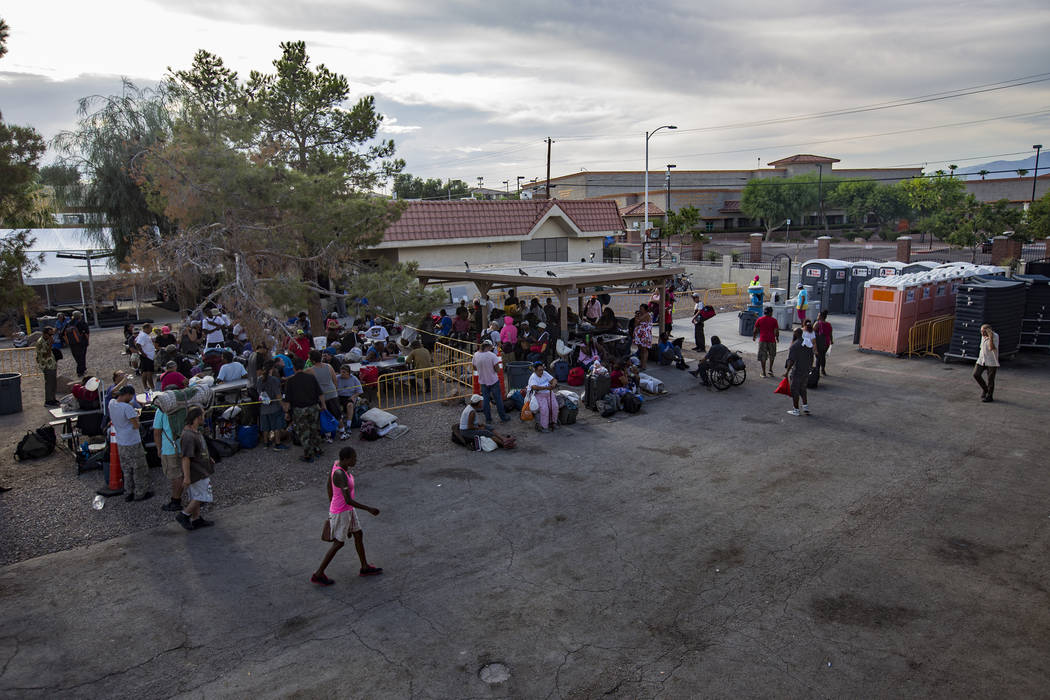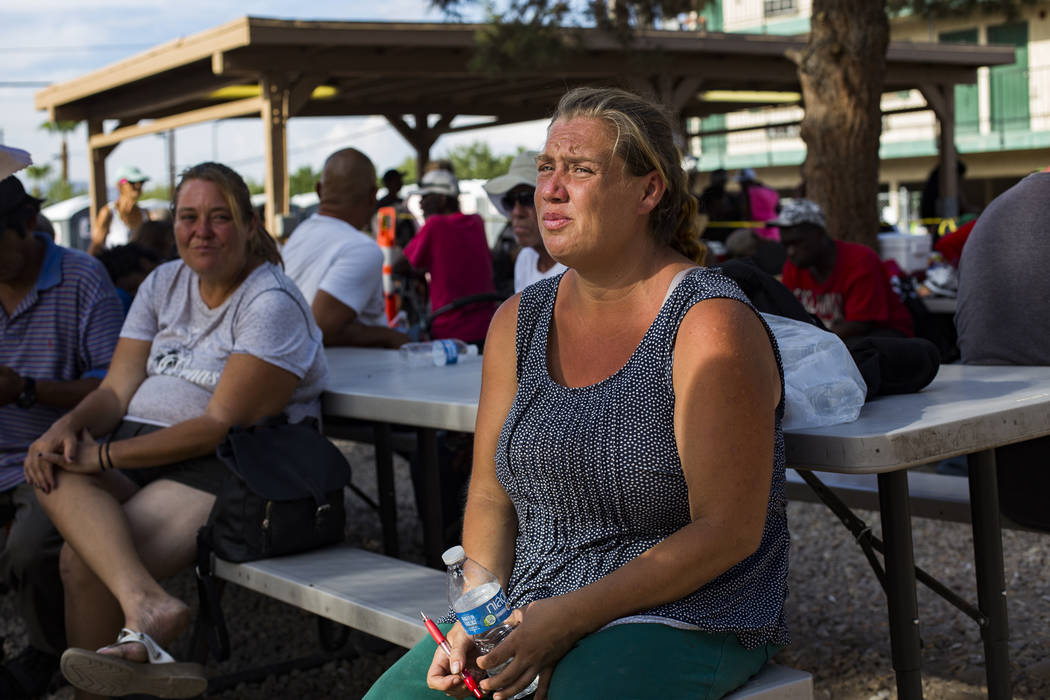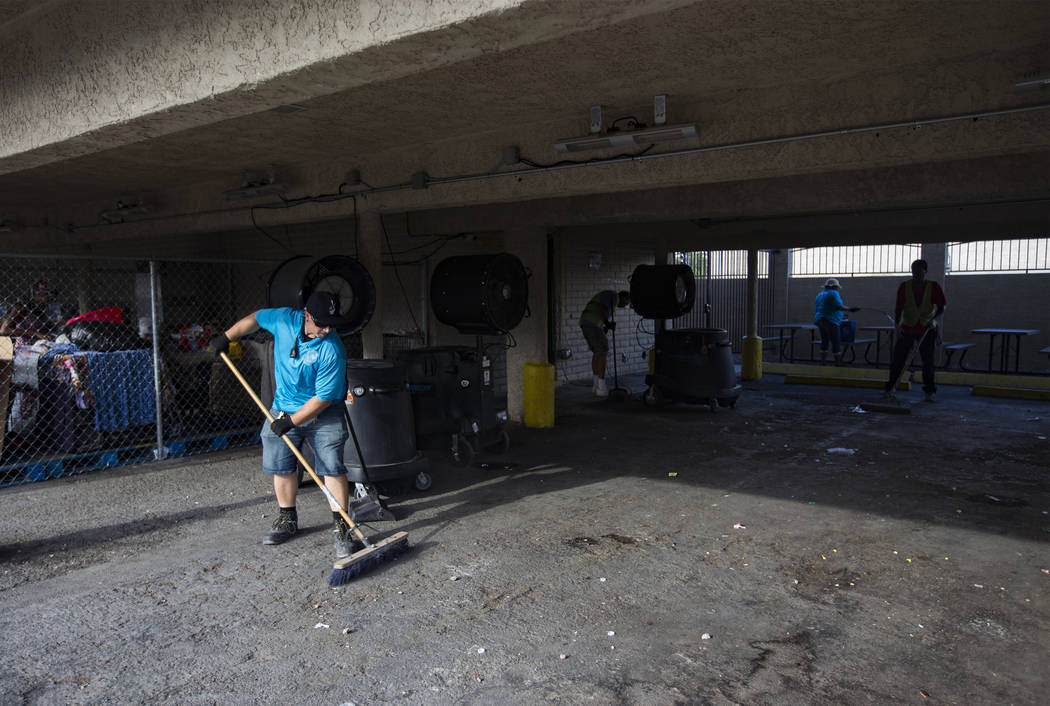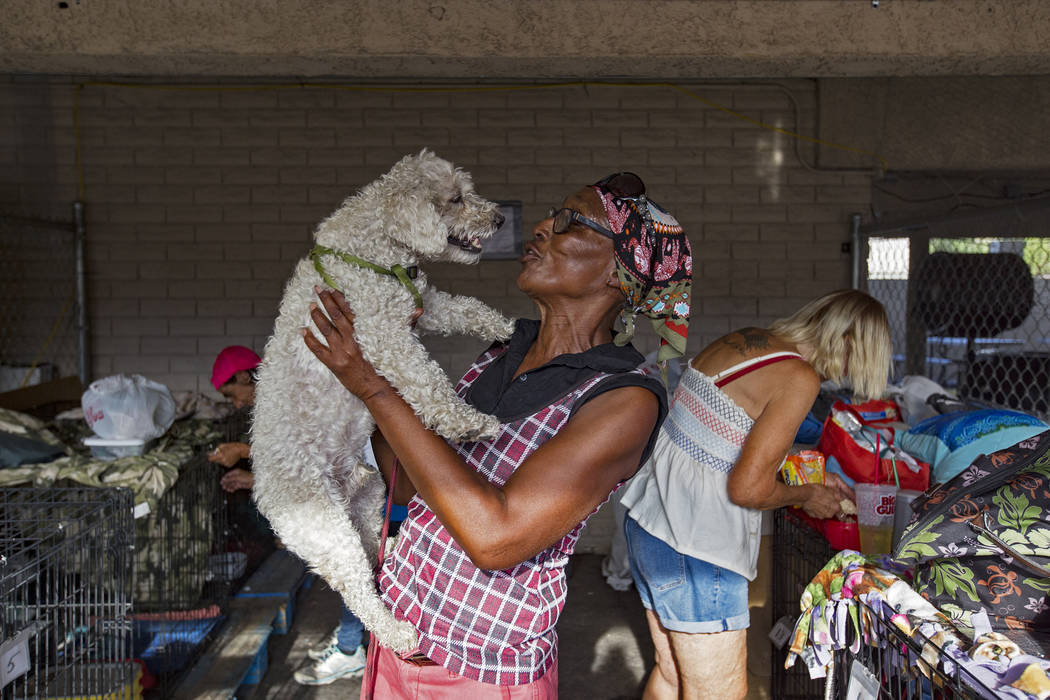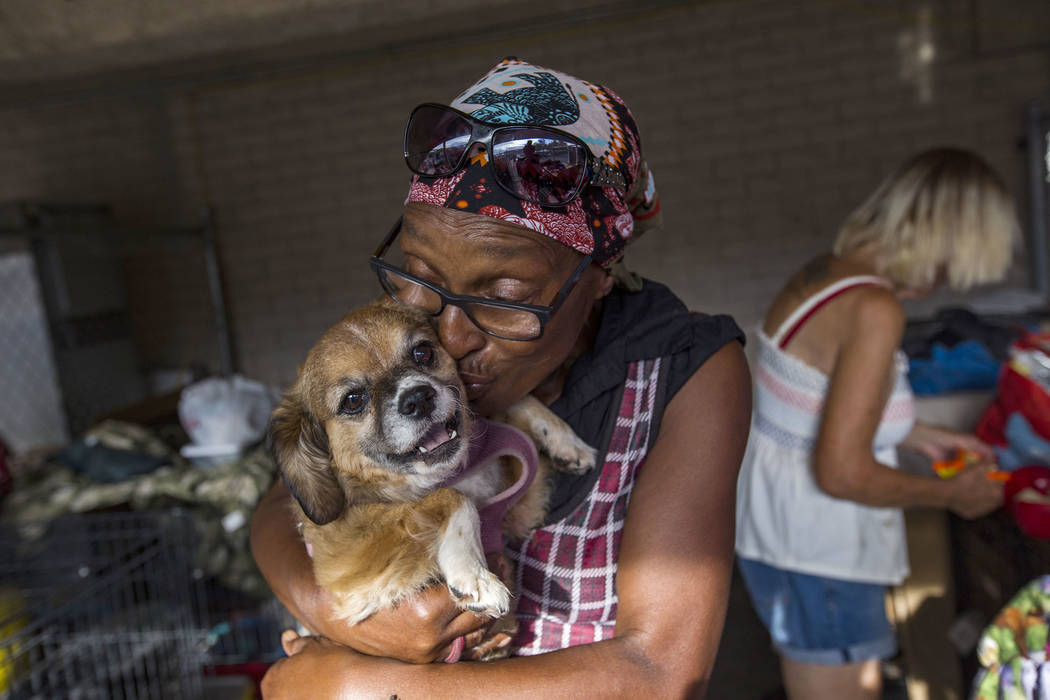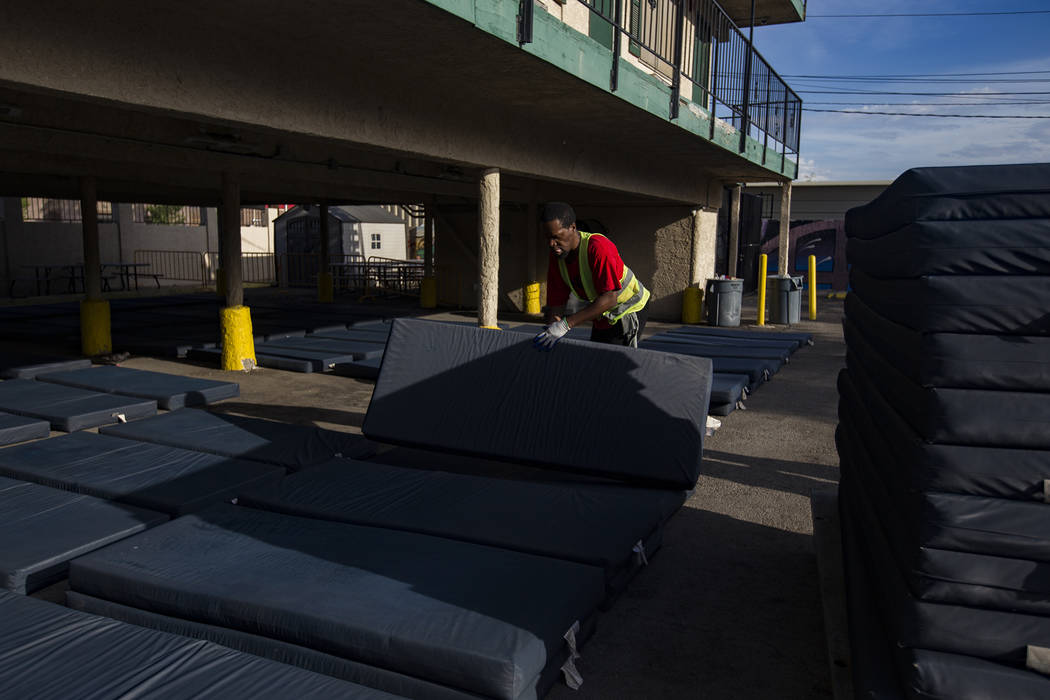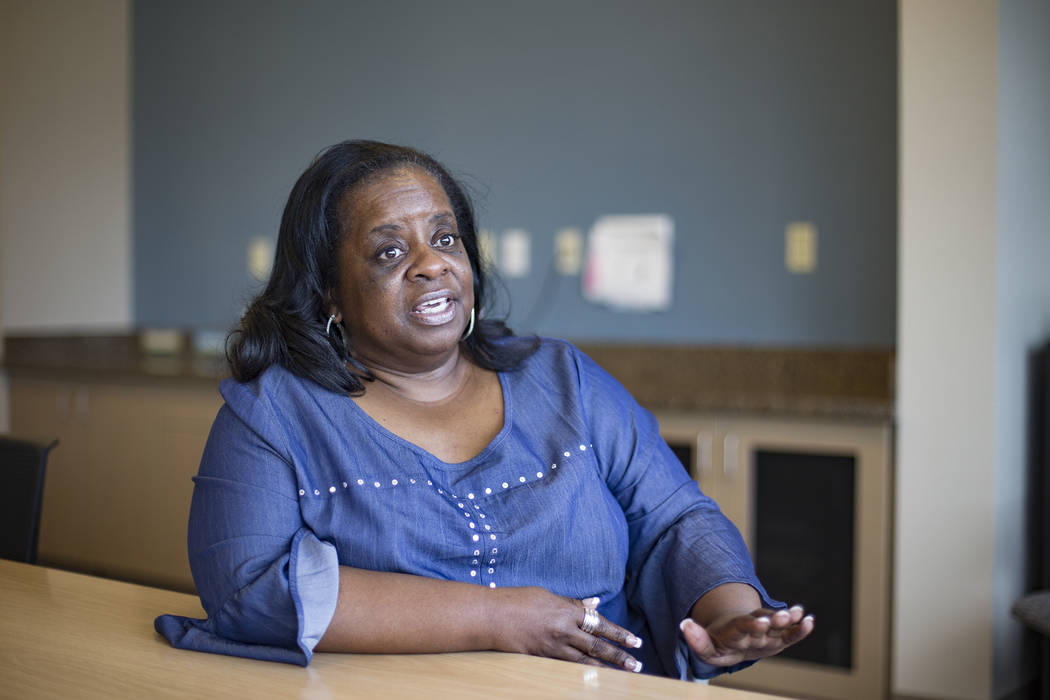Las Vegas Courtyard marks 1 year as 24/7 homeless resource center
The Courtyard Homeless Resource Center has seen its share of upheaval in the year since it became a 24/7 operation: The nonprofit hired to run the one-stop shop where the homeless can sleep and access a range of services was unceremoniously dumped less than five months after signing its contract, and staff turnover has been high.
But city officials say the first year of operations at the Courtyard off Foremaster Lane and Las Vegas Boulevard North has been a period of growth. And they believe the facility is already beginning to make a difference in addressing homelessness in Las Vegas.
“We’ve had the opportunity to learn a lot of things along the way, and we’re helping a lot of people, so that just drives us more to get to the full completion of the project,” said Kathi Thomas-Gibson, the city of Las Vegas’ director of community services, who oversees the courtyard.
Among the lessons learned, she said, were some logistical matters related to public health, like going from four port-a-potties to 14 and from three hand washing stations to six. It also quickly became apparent that cleaning needed to be a seven-day-a-week operation.
To gauge the impact, she and her staff used the Homeless Management Information System, software that tracks homeless people and their access to services scattered throughout Clark County, to pull up some data points.
They said data from the system shows that 6,270 individuals have been served at the Courtyard since July 26, 2018, when it opened as a full-time resource for the homeless.
Staff also helped set up 253 individuals with employment, enrolled 10 in substance abuse treatment and recovery programs and referred 116 to behavioral and mental health services.
The Courtyard also has provided 584 people with a one-way ticket to their hometowns to reconnect them with family and friends. Thomas-Gibson said that less than 1 percent of those people have re-entered the homeless assistance program.
But the number that Thomas-Gibson is proudest of is the one indicating how many homeless people have been placed in housing since the center began round-the-clock operations last year: 795, according to Courtyard staff.

‘That is huge’
“Drop the mic, right? That is huge,” she said. “That there are (hundreds of) individuals that are no longer homeless. That is the whole point of this.”
But now, Thomas-Gibson said, the Courtyard is dealing with chronically homeless individuals whose issues are more complex and often stem from mental or physical illness and substance abuse problems.
“The battle has been so intense for them, so the accomplishment is that much greater once they get housed,” she said.
But, in a state with the fewest affordable and available rentals in the country, housing remains the biggest challenge.
“We set this up to be a triage center so people would come get connected to the services that they needed most and then move on to housing,” Thomas-Gibson said. “But there’s a bottleneck because we don’t have enough affordable housing.”
Because of that, the city this month entered an agreement to offer master leases for 25 rental units, agreeing to spend nearly $226,500 this year.
The city also is weighing options to build affordable housing on acquired land in Ward 5 and the Historic Westside to help those transitioning out of the Courtyard.
That dovetails with an effort by Clark County, which recently set aside about $12 million in marijuana business licensing fees to fund transitional housing initiatives.
Funding for Courtyard operations remains another challenge.
The cost of operating the Courtyard has increased — its budget this fiscal year is $4.3 million compared with $3.075 million last year — in part because the city took over operations and partly because it drew far more homeless people than officials originally anticipated.
More than 300 people typically stay overnight, double the 150 people they projected last year. That makes budgeting difficult, Thomas-Gibson said.
“Into the future, our concern is always that the demand has increased or is growing faster than we anticipated,” she said. “I can’t see around corners what happens if we hit 500 instead of 300. Five hundred is supposed to be in 2021, but what happens if we hit that in 2020?”
Private contributions sought
Las Vegas Mayor Carolyn Goodman has said the Courtyard cannot be sustained by the city alone and has established the Mayor’s Fund for Las Vegas LIFE to give businesses, nonprofits and private individuals an easy way to support city projects, including the Courtyard.
By November, the fund had raised nearly $500,000, of which 25 percent — $125,000 — was allocated for homeless services, officials said.
Thomas-Gibson also addressed the upheaval at the Courtyard in the months after it went 24/7.
In November, less than five months after signing a two-year, $2.1 million contract with the Southern Nevada Community Health Improvement Program, the city paid the nonprofit nearly $48,500 to terminate the contract.
About 16 people lost their jobs immediately, and at least 13 employees out of a total of about 30 working at the Courtyard were terminated and replaced in subsequent months.
“We want to ensure that the quality and quantity of services that we’re committed to provide is there. So we stepped in to ensure that level of care is there,” Thomas-Gibson said.
She said the city is in talks about bringing in another operator to oversee day-to-day operations, but officials are biding their time, as there are a “lot of moving parts” with the demolition of outdated structures on the site expected to start before the end of the year and construction of new facilities set to begin in 2020.
Other local providers of services to the homeless say they’ve watched the Courtyard’s growing pains closely.
The facility has “been able to draw people that normally wouldn’t go into shelters,” said Salvation Army Maj. Randy Kinnamon, who was part of the original advisory group that laid the groundwork for the project. But he noted that funding was one of his biggest concerns when the city began looking for groups to operate the Courtyard.
“It was just not enough money for the agency to sustain. … I think that’s probably the biggest glitch,” he said. “(The city) didn’t really intend to run this outdoor courtyard themselves. I think they realized in the process that it did in fact cost a lot more money than they thought.”
‘Huge environmental shift’
Brittany Corder, the services director at the Care Complex, a small provider next door that sees as many as 200 a day, said the Courtyard “got off to a rocky start as far as who is going to be the operator.”
But in the past year, she said, the Care Complex has seen a decline of roughly 10 percent in clients, probably because the Courtyard has been “filling a gap in services.”
“The biggest thing is that people aren’t on the street anymore,” she said. “That’s just a huge environmental shift.”
Thomas-Gibson said the Courtyard now serves as the front door for the Continuum of Care, the regional approach to homelessness comprising several local service providers. And many in the Corridor of Hope agree that it has improved coordination among providers.
This year’s annual homeless census counted 5,286 people living in shelters and on the streets in the county, a decline of 13 percent since last year.
On Thursday, an uncharacteristically cloudy and humid day, a knot of Courtyard residents sat around a shaded picnic table and tried to keep cool under a fan and misters designed to give them a respite from the unrelenting summer heat.
A security guard stood nearby, a towel atop his head to absorb his sweat.
While some residents said they were unclear on what services were available, most knew they had options that could help them get back on their feet.
Romi Ortiz, 39, who has spent three years on the Las Vegas streets, said she remembered the Courtyard in its infancy and has seem many improvements, especially among the staff.
“Now we have customer service,” she said. “… They’re much more coordinated now. They give us a smile now.”
But more people are coming to the Courtyard than before, she noted, and sometimes there are not enough mats to accommodate everybody.
Ronald Dehart, 59, has been at the Courtyard with his Chihuahua, Sadie, almost since it opened. Staff was able to help Dehart, blind in his right eye, get signed up for a monthly $771 disability payment.
But that’s not enough to get him off the streets, he said.
A job and a new life
Harlan Thompson, who now works at the Courtyard as an operations supervisor, remembers when it was just a trailer offering job placement, only open during the day.
His five children also remember.
“They remember sleeping outside, over a year ago, right there in that spot,” he said, pointing. “It just stuck with them.”
At that time, just over two years ago, Thompson was encamped in what is now the parking lot of the Courtyard. He had just given his five children, ages 6 to 13, over to the Department of Family Services. He had lost his job as a cook on the Strip, and he and the mother of his children were using meth.
But after entering treatment and landing the job at the Courtyard, he recently secured a two-bedroom apartment for $500 a month and regained custody of his children.
Thompson is one of about 20 former Courtyard residents or visitors who have been hired to work there. He was promoted to supervisor and now makes almost $17 an hour. Other city agencies also have stepped up to hire residents.
“We want to walk our talk,” Thomas-Gibson said. “We’re asking the private sector to be a second-chance employer, and we have to be willing to be the same.”
On Thursday, Thompson emptied the garbage canisters and tossed the contents in a dumpster next to the 456 bins for storage that hold clients’ belongings.
“I thought I’d never make it out of that hole. … but I’m a perfect example to these guys that there is a way out if you really do want the help,” he said.
“I still have a lot of high hopes for this place, I do.”
Contact Briana Erickson at berickson@reviewjournal.com or 702-387-5244. Follow @ByBrianaE on Twitter.



